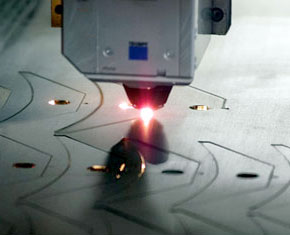Il taglio di acciai inossidabili è spesso considerato difficile. Questo è dovuto al fatto che certi acciai inox, ma non tutti, sono caratterizzati da proprietà del materiale che si traducono nella criccatura dei bordi quando esposto a condizioni severe durante le lavorazioni. Sono principalmente gli austenitici, austeno-ferritici e alcuni acciai ferritici e martensitici che causano problemi durante il loro taglio.
Gli acciai ferritici e martensitici raramente sono difficili da lavorare a macchina, anche se gli acciai ferritici possono dare origine a problemi di impastamento e alla formazione di bordi criccati. Gli acciai martensitici possono, naturalmente, essere difficili da lavorare a macchina se sono stati temprati a durezze elevate, anche se questo non è un comportamento tipico degli acciai inossidabili in particolare, ma avviene in tutti i materiali con durezze elevate.
Invece il fatto che gli acciai austenitici e austeno–ferriti diano problemi è dovuto alla combinazione delle proprietà di questi materiali che sono relativamente morbidi. Le loro proprietà sono tali che la durezza non può più essere utilizzata come un’indicazione di lavorabilità del materiale.
Lavorabilità è un concetto complesso, che abbraccia diversi fattori e non è solo una questione di usura degli utensili. Oltre all’effetto del materiale sull’usura dell’utensile, ad esempio sulla vita dell’utensile, è anche necessario considerare il suo effetto sulla grandezza delle forze di taglio: ad esempio, la forma del truciolo e le caratteristiche superficiali della superficie lavorata influiranno sulla lavorabilità complessiva di un materiale.
Le proprietà caratteristiche degli acciai inossidabili possono influenzare tutti i quattro fattori di lavorabilità: in generale, si può dire che maggiore è il contenuto di lega di un acciaio inossidabile, più difficile è la sua lavorabilità alle macchine. Le proprietà caratteristiche, che rendono difficile la lavorazione alle macchine degli acciai inossidabili, si trovano in misura maggiore o minore in tutti i tipi di acciai inossidabili, ma sono più marcate nei tipi austenitici e austeno-ferritici.
Essi si possono riassumere in cinque punti:
– Gli acciai inossidabili induriscono notevolmente durante le lavorazioni;
– Gli acciai inossidabili hanno una bassa conducibilità termica;
– Gli acciai inossidabili hanno alta tenacità;
– Gli acciai inossidabili tendono ad essere “pastosi”;
– Gli acciai inossidabili hanno scarse caratteristiche di rottura del truciolo.
—————————————————————————————————————————————————-
English version
Stainless steels : cutting and working
Cutting of stainless steels is often considered difficult. This is due to the fact that some stainless steels, but not all, are characterized by material properties that result in edge cracking when exposed to severe conditions during machining. Mainly all the Austenitic and Austeno-ferritic steels and a few Ferritic and Martensitic steels cause problems during their cutting.
Ferritics and Martensitics are seldom difficult to work with, although ferritic steels can give rise to problems of kneading and to the formation of cracked edges. Martensitic steels can, of course, be difficult to machine to machine if they have been hardened to high hardness, although this is not a typical behavior of stainless steels in particular, but occurs in all materials with high hardness.
The fact that austenitic and austeno-ferritic steels cause problems, is due to the combination of the properties of these materials that are relatively soft. Their properties are such that the hardness can no longer be used as an indication of workability of such materials.
Workability is a complex concept, which includes several factors and is not just a matter of tool wearing. In addition to material characteristics on tool wearing, such as the life of the tool, we must also consider such effects on the magnitude of the cutting forces: for instance, the chip shape and the surface characteristics of the machined surface will affect the final workability of materials.
The stainless steels characteristics can affect all the four factors of workability: generally speaking, we can say : the higher the alloy content of a stainless steel, the harder its machinability. The stainless steels characteristics, which make them hard to machining, we find in all types of steels to a bigger or smaller extent, but are more relevant in the austenitic and austeno-ferritic grades.
They can be summarized in five points:
- stainless steels will harden relevantly during processing;
- stainless steels show a low thermal conductivity;
- stainless steels show high tenacity;
- stainless steels tend to be “soft”;
- stainless steels have poor characteristics of chip breakage.

